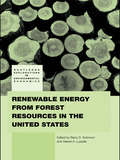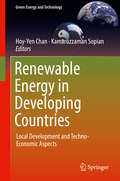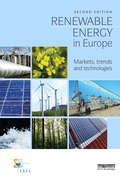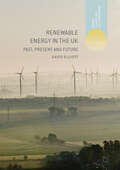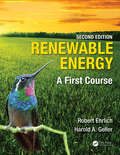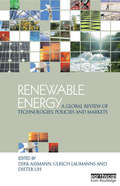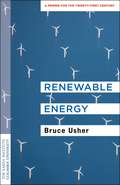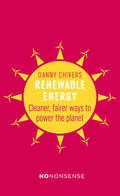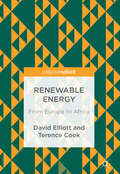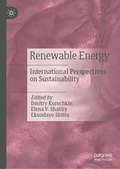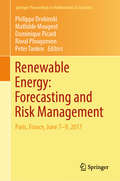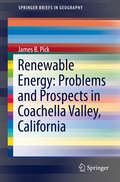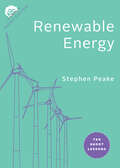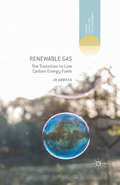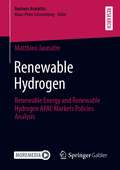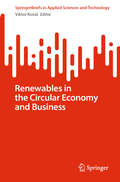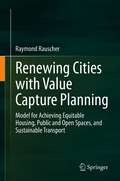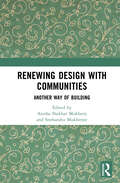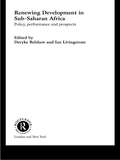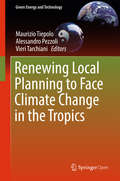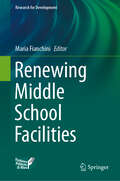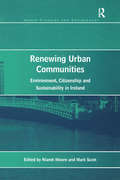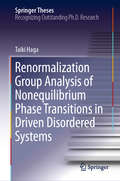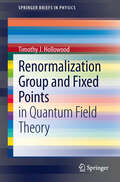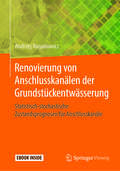- Table View
- List View
Renewable Energy from Forest Resources in the United States (Routledge Explorations in Environmental Economics)
by Barry D. Solomon Valerie A. LuzadisInterest in biomass energy resources from forests, farms and other sources has been rapidly increasing in recent years because of growing concern with reducing carbon dioxide emissions and developing alternatives to increasingly scarce, expensive and insecure oil supplies. The uniqueness of this book is its coverage of biomass energy markets in the US from an economic as well as technical perspective. Existing books typically focus on single markets or technical aspects at the exclusion of economics, and have given greater coverage to biomass energy outside the US. This edited collection has three main parts. Part One provides a historical overview of forest biomass energy use in the US; the major technologies, economics, market prospects, and policies. Part Two presents forest biomass energy assessments, including life cycle and sustainability perspectives, and Part Three includes five sets of regional case studies. After reviewing the history of wood energy use in the US and technology options, the book shows that forests could displace sixteen per cent of domestic transportation fuel use in 2030. Renewable Energy from Forest Resources in the United States includes a Foreword from Chris Flavin, President of the Worldwatch Institute.
Renewable Energy in Developing Countries: Local Development And Techno-economic (Green Energy and Technology)
by Hoy-Yen Chan Kamaruzzaman SopianThis book discusses aspects of policy and techno-economic analysis of renewable energy in developing countries. Renewable energy technologies have been one of the most important strategies in addressing sustainable energy development and climate change. The roles of renewable energy in developing countries are vital, which include the accessibility of modern energy services in rural areas, climate change mitigation, energy security, green job creation and eventually improvement of quality of life. Part I of this book focuses on policy and strategy, while Part II focuses on technology development and feasibility. Chapters are contributed by leading experts from the ASEAN Center of Energy, government agencies, industries, and universities from five developing countries, including Malaysia, Indonesia, Vietnam, Brunei Darussalam and Bangladesh.
Renewable Energy in Europe: Markets, Trends and Technologies
by European Renewable European Renewable Energy CouncilHow can the European Union meet its binding 20% renewable energy target in final energy consumption by the year 2020? Which sources offer the best prospects for realizing this goal? These are the questions answered by this key book which analyses the current situation of renewable energy in Europe, examines the latest technological, financial and economic developments, and outlines ways in which the renewable energy market can be developed. The book is divided into sections examining the integration of renewable energy, electricity, heating and cooling as well as biofuels. All the main technologies are covered, with exploration of: ' benefits and applications ' costs and prices ' markets and installed capacity ' policy instruments ' key countries and success stories ' targets and long term potential This will be essential reading for policy decision-makers at all levels and to all those involved in the development of the renewable energy industry.
Renewable Energy in the UK: Past, Present and Future (Energy, Climate and the Environment)
by David ElliottThis book offers a detailed account of how renewable energy has moved from the margins to the mainstream in the UK, and of the battles that have been fought to achieve this, trawling through the often troubled history of government involvement. The book examines how renewables became what now seem likely to be the dominant energy sources of the future. Renewable energy technologies, using solar and wind power and other natural energy sources, are now supplying around 30% of UK electricity and appear set to continue expanding to supply around 50% within the next decade. Although the emphasis of the book is on the UK, developments there are compared with those in other countries to provide an overall assessment of the relevance of the UK experience. Chapters explore why the UK still lags behind many other countries in deploying renewables, in part, it is argued, due to its continued reliance on nuclear power. The book ends with a discussion on what sort of changes may be expected over the coming years. The author does not assume a single answer, but invites readers to consider the possibilities.
Renewable Energy: A First Course (Second Edition)
by Robert Ehrlich Harold A. Geller<p>This revised edition is fully updated and continues to provide the best in-depth introduction to renewable energy science. It focuses mainly on renewable energy, but also addresses nonrenewable energy (fossil fuels and nuclear technology). The coverage extends from the basic physics to conservation, economic, and public policy issues, with strong emphasis on explaining how things work in practice. <p>The authors avoid technical jargon and advanced math, but address fundamental analytical skills with wide application, including: <p> <li>Two brand new chapters giving an introduction to population dynamics and statistical analysis for energy studies Additional self-study problems and answers <li>More worked examples <li>Up-to-date coverage of areas such as hydraulic fracturing, integration of renewable energy to power grid, and cost.</li> </p>
Renewable Energy: A Global Review of Technologies, Policies and Markets
by Ulrich Laumanns Dirk A Dieter Uh'offers knowledge and inspiration to promote renewable energy in developing and industrialized countries' Klaus Toepfer, Executive Director of UNEP From technology to financing issues, Renewable Energy offers a comprehensive and authoritative review of the determining factors that drive worldwide dissemination of renewable energy technologies. With a clear emphasis on policy and action, contributions from internationally renowned experts combine to form a holistic picture of the current status, impacts and future potential of renewable energy. Addressing the situation in both developing and developed countries, each chapter reviews in detail a different issue, to present extensive information on social, environmental, political, economic and technological aspects. This will be essential reading for professionals in renewable energy, in particular policy-makers, researchers, NGOs and energy consultants, and a valuable resource for teachers and students of renewable energy, environmental studies, development studies, political science and international relations.
Renewable Energy: A Primer for the Twenty-First Century (Columbia University Earth Institute Sustainability Primers)
by Professor Bruce UsherFrom wood to coal to oil and gas, the sources of energy on which civilization depends have always changed as technology advances. Now renewables are overtaking fossil fuels, with wind and solar energy becoming cheaper and more competitive every year. Growth in renewable energy will further accelerate as electric vehicles become less expensive than traditional automobiles. Understanding the implications of the energy transition will prepare us for the many changes ahead.This book is a primer for readers of all levels on the coming energy transition and its global consequences. Bruce Usher provides a concise yet comprehensive explanation for the extraordinary growth in wind and solar energy; the trajectory of the transition from fossil fuels to renewables; and the implications for industries, countries, and the climate. Written in a straightforward style with easy-to-understand visual aids, the book illuminates the strengths and weaknesses of renewable energy based on business fundamentals and analysis of the economic forces that have given renewables a tailwind. Usher dissects the winners and losers, illustrating how governments and businesses with a far-sighted approach will reap long-term benefits while others will trail behind. Alongside the business and finance case for renewable energy, he provides a timely illustration of the threat of catastrophic climate change and the perils of delay. A short and powerful guide to our energy present and future, this book makes it clear that, from both economic and environmental perspectives, there is no time to lose.
Renewable Energy: Cleaner, fairer ways to power the planet (No-Nonsense Guides #35)
by Danny ChiversFew people doubt the threat of climate change and the urgent need to conquer fossil fuel addiction. But can renewable sources of energy ever be sufficient to provide modern societies with a decent quality of life? This book is clear. They can. And it outlines the strategies to break the barriers to a 100% renewable world. Danny Chivers presents a compelling introduction to renewable technologies for non-technical readers (solar, wind, hydro, geothermal and ambient heat, wave and tidal, fuel crops, and energy from waste) and a roadmap to powering the world, not just sustainably, but democratically.
Renewable Energy: From Europe To Africa (Issues In Environmental Science And Technology Ser. #19)
by David Elliott Terence CookSignificant progress has been made by industrial countries to reduce emissions from the use of fossil fuels, but as the economies of the less-developed regions of the world begin to expand, they too will face similar challenges. This book looks at energy transitions being made in developing countries, focusing on the adoption of renewable energy systems in Africa, for example under the UN Sustainable Energy for All programme, but also by the EU in the Former Soviet countries of Eastern and Central Europe. It draws on experience from involvement with programmes in the EU and Africa and will be of great interest to academics, policy makers and practitioners in the development aid and renewable energy policy fields.
Renewable Energy: International Perspectives on Sustainability
by Elena V. Shabliy Dmitry Kurochkin Ekundayo ShittuThis book bringing together leading researchers in the field of renewable energy to discuss sustainability on a broad scale and to examine the status quo of renewable energy industry development in a global context. The volume starts with the European Union, then reviews current trends in the United States as well as the Middle East, Central Asia, and Latin America. It moves on to analyze the German transition to one hundred percent renewable energy economy and energy systems (Energiewende) with a climate protection plan and sustainable economic development; and continues on to examine the determinants of the adoption of sustainable solutions in Finland and discuss the renewable energy agenda in the European Union with the 17 Sustainable Development Goals at its core. Climate change has become one of the main global drivers for policy and this book discusses both it’s over all global development as well as spotlighting localized progress across multiple continents. Over one hundred and fifty countries have developing sustainable energy policies, tax incentives, and laws. China remains the leader in renewable energy generation; and countries including the United States, the UK, India, Spain, and Turkey, compete in the Renewable Energy Sector to attract investments. In 2018, global investments in renewables exceeded $200 billion. The state of Bahia in Brazil has been experiencing a surge in wind energy production; and public policy has had a positive effect on that expansion. Kazakhstan is a country with great renewable energy prospects, particularly in wind, hydropower plants, and solar energy. This book is a comprehensive overview and invaluable reference for all those in the renewable energy sector.
Renewable Energy: Paris, France, June 7-9, 2017 (Springer Proceedings in Mathematics & Statistics #254)
by Philippe Drobinski Mathilde Mougeot Dominique Picard Riwal Plougonven Peter TankovGathering selected, revised and extended contributions from the conference ‘Forecasting and Risk Management for Renewable Energy FOREWER’, which took place in Paris in June 2017, this book focuses on the applications of statistics to the risk management and forecasting problems arising in the renewable energy industry. The different contributions explore all aspects of the energy production chain: forecasting and probabilistic modelling of renewable resources, including probabilistic forecasting approaches; modelling and forecasting of wind and solar power production; prediction of electricity demand; optimal operation of microgrids involving renewable production; and finally the effect of renewable production on electricity market prices. Written by experts in statistics, probability, risk management, economics and electrical engineering, this multidisciplinary volume will serve as a reference on renewable energy risk management and at the same time as a source of inspiration for statisticians and probabilists aiming to work on energy-related problems.
Renewable Energy: Problems and Prospects in Coachella Valley, California (SpringerBriefs in Geography)
by James B. PickThe book analyzes the problems and potential of renewable energy development for the Coachella Valley of California and provides a useful case study for renewable energy feasibility assessments for other areas. A conceptual model, Integrated Policy Assessment Theory for Renewable Energy, is given and justified for renewable energy development in the Valley. Further, Central Place Theory, well known in urban geography, is discussed and it is seen to be very relevant to the understanding the Coachella Valley’s city sizes and renewable energy markets, compared to the greater Los Angeles region. The book’s research methods include geospatial mapping and analysis and interviews leaders in small innovative firms, government agencies, and nonprofits. The many findings of the book include evaluation of how the Valley’s socioeconomic and transportation features influence renewable energy development, the scope of markets for solar and wind energy in the Valley, spatial confluences of renewable energy facilities with other features, and the future potential of ground-source heat pumps. Benchmark comparison of the Coachella Valley is done with two leading wind and solar regions elsewhere in the country, to assess the Valley’s evolution and opportunities in renewable energy. The book concludes by evaluating the prospects and problems for the growth of renewable entrepreneurship, manufacturing, assembly, and operations in Coachella Valley. This leads to policy recommendations grounded in the book’s research findings, which are intended for use by governments, businesses, and nonprofits. The hope is that many of the developmental experiences from the Coachella Valley will be helpful not only within the Valley but to other communities nationwide and worldwide.
Renewable Energy: Ten Short Lessons (Pocket Einstein Series)
by Stephen PeakeAn expert introduction to the fascinating world of renewable energy and the transition from fossil fuels to clean energy that lies at the heart of a brighter climate future.In Renewable Energy: Ten Short Lessons, Stephen Peake distills the key issues of this timely subject, examining how we can harness the power of a range of groundbreaking energy technologies most effectively to achieve a sustainable energy future. Renewable energy is central to managing climate change and our transition to a sustainable energy supply for the 10 billion of us who will populate the earth by 2050. But how will we cope without fossil fuels to heat, cool, and light our buildings, power our industry, and run our transport systems? And are some renewables better than others? Packed full of easy-to-understand diagrams and fact boxes, these ten lessons cover all the basics, as well as the latest understanding and developments, to enlighten the nonscientist. About the series: The Pocket Einstein series is a collection of essential pocket-sized guides for anyone looking to understand a little more about some of the most important and fascinating areas of science in the twenty-first century. Broken down into ten simple lessons and written by leading experts in their field, the books reveal the ten most important takeaways from those areas of science you've always wanted to know more about.
Renewable Gas: The Transition to Low Carbon Energy Fuels (Energy, Climate and the Environment)
by Jo AbbessThe author looks at the prospects for a transition from natural gas to low carbon gas, which could take several decades, and at how this will depend on the evolution of the fossil fuel industry. She investigates the technologies and energy systems for making the best use of renewable gas resources.
Renewable Hydrogen: Renewable Energy and Renewable Hydrogen APAC Markets Policies Analysis (Business Analytics)
by Matthieu JaunatreHydrogen has recently become a popular topic and is often described as the missing link to a successful green energy transition. However, hydrogen can only contribute to a carbon-free future if it is produced from renewable energy. The ability to produce renewable hydrogen is linked to the renewable energy production capacity, which is itself conditioned by the underpinning renewable energy policies. This publication offers a review and an analysis of the renewable energy and hydrogen policies of five countries of the APAC markets: Australia, China, Japan, South-Korea and Taiwan. The review is complemented by interviews of renewable energy policy experts, renewable energy project developers and potential renewable hydrogen off-takers. Altogether, the policies analysis and experts’ inputs provide a comprehensive overview of the status, drivers, limitations, and recommendations for the use of renewable hydrogen as a solution for deep decarbonization. Finally, the author proposes a method to assess the potential of renewable hydrogen to decarbonize hard-to-abate industries (ammonia, methanol, oil refining and steel manufacturing) based on existing renewable energy policies.
Renewables in the Circular Economy and Business (SpringerBriefs in Applied Sciences and Technology)
by Viktor KovalThis book is an interdisciplinary study linking the circular economy and renewable energy, satisfying the public interest in sustainable energy solutions from a social, political, economic, and technological perspective. The book considers all subjects that can help solve the problems of creating a sustainable energy system through the production of clean energy with integration into the national energy system without compromising reliability and improving energy security.
Renewing Cities with Value Capture Planning: Model for Achieving Equitable Housing, Public and Open Spaces, and Sustainable Transport
by Raymond RauscherThe book offers a model for city development and renewal based on land value capture (called ‘value capture’). Firstly, a review is presented of cities around the world that are currently using value capture. From these city examples the author shows how any state, city or regional government can adopt value capture policies. Looking at recent events the author reviews the implications of the coronavirus pandemic (2020) for future planning (including value capture) of cities and regions (particularly noting healthy cities planning). The development of a value capture planning (VCP) model is then outlined. The basis of the model is reflected in its planning components, being: Housing (affordable, social and market housing); Public and Open Spaces (natural areas, open spaces and public spaces); and, Sustainable Transport (rail, bus, and active transport). The VCP model is devised to provide an economic and planning tool that can be utilised in addressing each of these planning components. This tool includes data entry tables and explanations of how these tables are applied. Four case study cities (within Australia) currently undergoing renewal are selected for the model to be applied to. The areas were chosen to represent contrasting urban settings and types of development and renewal, including: inner city, middle ring city; growth centre city; and, regional capital city. The current (2020) active renewal programs within these areas include (city in brackets): Central to Eveleigh Renewal Area (CERA) (City of Sydney); Sydenham to Bankstown Urban Renewal Corridor (SBURC) (Canterbury Bankstown City); Gosford City Centre Revitalisation (GCCR) area (Gosford City); and, Newcastle City Renewal Area (NCRA) (Newcastle City). The reader is walked through (graphically) the backgrounds of these case study cities, including geography, development trends and details of renewal plans. Conclusions on the VCP model application are outlined for each study area (within that chapter) and for the cumulative results across all study areas (final chapter). With these conclusions, the application of the model to any city or region anywhere in the world is outlined. Finally, on a practical level the reader would be interested in how value capture is administered through programs (including the roles of government, developers and the community). Summing up, the book offers the reader an understanding of current city planning and the tools (like value capture) that will be required for future planning.
Renewing Design with Communities: Another Way of Building
by Anisha Shekhar Mukherji and Snehanshu MukherjeeThis book looks at alternative ways of analyzing traditional and contemporary architectural design and building practices in South Asia with a special focus on India. It showcases how collaborative projects between architects and local communities and drawing from local building traditions can lead to sustainable and equitable practices in architecture. The volume includes an analysis of projects in rural, tribal, and urban areas of India and Nepal and first-hand accounts of architects, teachers, and professionals engaged in the theory and practice of design and architecture. It examines the differences between the individualistic and the collective approach and explores the meaning of architecture as a process and as a product and as a decentralized, ecologically, and locally sensitive way of designing. While comparing traditional and modern methods of building, it also examines the impact of each method on the community, the economy and the surrounding environment. This book will be of interest to researchers and students of architecture, urban studies, urban planning, urban ecology, urban geography, and sustainable development. It will also be useful for architects, planners, urban designers, and professionals associated with these disciplines.
Renewing Development in Sub-Saharan Africa: Policy, Performance and Prospects
by Ian Livingstone Deryke BelshawRenewing Development in Sub-Saharan Africa reviews the debates and brings together specialist contributions, to provide a clear guide to the major complexities of African development. They lay the foundation for designing a range of individual country-specific policy-sets, in which the strategic components are prioritized according to each country's constraints and opportunities. The emphasis of the book is on the identification of effective strategies that will enable individual countries to most effectively exploit their growth opportunities and to meet poverty-reducing and other key equity objectives.
Renewing Local Planning to Face Climate Change in the Tropics
by Maurizio Tiepolo Alessandro Pezzoli Vieri TarchianiThis book is open access under a CC BY 4. 0 license. This book aims to inspire decision makers and practitioners to change their approach to climate planning in the tropics through the application of modern technologies for characterizing local climate and tracking vulnerability and risk, and using decision-making tools. Drawing on 16 case studies conducted mainly in the Caribbean, Central America, Western and Eastern Africa, and South East Asia it is shown how successful integration of traditional and modern knowledge can enhance disaster risk reduction and adaptation to climate change in the tropics. The case studies encompass both rural and urban settings and cover different scales: rural communities, cities, and regions. In addition, the book looks to the future of planning by addressing topics of major importance, including residual risk integration in local development plans, damage insurance and the potential role of climate vulnerability reduction credits. In many regions of the tropics, climate planning is growing but has still very low quality. This book identifies the weaknesses and proposes effective solutions.
Renewing Middle School Facilities (Research for Development)
by Maria FianchiniThis book draws on important original transdisciplinary research to address a wide range of issues relating to the remodeling of existing schools for pre-teenagers to fit them to various novel teaching models (e.g. collaborative learning, ICT integration, and out-of-classroom working) and to create effective educational environments for the future.The strong relationship between people’s wellbeing, physical environment and student learning in schools has already been extensively studied in international research. At the same time, a number of different scenarios of possible innovations are now emerging, and these require conscious choices in terms of designing both the ways and the places where educational processes can be developed.The principal focus of this research was the relationship between infrastructure, activities, and school communities.The book is divided into three sections, the first of which discusses conceptual aspects and outlines innovative renewal strategies. The second section describes a participatory research process developed in five case studies of lower-secondary or middle schools with the aim of updating our knowledge about such schools and identifying emerging issues. The last section presents case studies, operational tools, and design strategies that aid decision-making and support interventions to renew school facilities. The book is intended mainly for scholars of architecture and education, but is also of interest to a wider readership, including principals, teachers, designers, decision-makers in school communities, and heads of municipal education departments.
Renewing Urban Communities: Environment, Citizenship and Sustainability in Ireland (Urban Planning and Environment)
by Mark ScottIreland is now an urban society, and both parts of the island have experienced rapid urban-generated growth and new patterns of development in recent years. This inter-disciplinary book adopts an all-Ireland perspective to investigate the tension that exists between sustainable urban development values and rhetoric - such as increased densities, brown field development, the compact city and social inclusion - and the emerging geography of urban Ireland, influenced by consumer and lifestyle choices. The introduction provides an overview of the dynamics of urban change, particularly during the 1990s, and the experience of rapid economic growth. The following chapters are divided into two parts, considering sustainable urban environments, and sustainable communities. This book will appeal to students, academics, policy and decision-makers, given that it adopts both a qualitative and quantitative approach, and introduces a range of new empirical studies covering both physical and social sustainable development.
Renormalization Group Analysis of Nonequilibrium Phase Transitions in Driven Disordered Systems (Springer Theses)
by Taiki HagaThis book investigates phase transitions and critical phenomena in disordered systems driven out of equilibrium. First, the author derives a dimensional reduction property that relates the long-distance physics of driven disordered systems to that of lower dimensional pure systems. By combining this property with a modern renormalization group technique, the critical behavior of random field spin models driven at a uniform velocity is subsequently investigated. The highlight of this book is that the driven random field XY model is shown to exhibit the Kosterlitz–Thouless transition in three dimensions. This is the first example of topological phase transitions in which the competition between quenched disorder and nonequilibrium driving plays a crucial role. The book also includes a pedagogical review of a renormalizaion group technique for disordered systems.
Renormalization Group and Fixed Points
by Timothy J HollowoodThis Brief presents an introduction to the theory of the renormalization group in the context of quantum field theories of relevance to particle physics. Emphasis is placed on gaining a physical understanding of the running of the couplings. The Wilsonian version of the renormalization group is related to conventional perturbative calculations with dimensional regularization and minimal subtraction. An introduction is given to some of the remarkable renormalization group properties of supersymmetric theories.
Renovierung von Anschlusskanälen der Grundstückentwässerung: Statistisch-stochastische Zustandsprognosen für Anschlusskanäle
by Andrzej RaganowiczDas Buch gibt eine Anleitung für das komplette Sanierungsspektrum, beginnend bei Grundstücksanschlüssen über die Zustandserfassung, Bewertung, Planung und die Ausführung der Renovierungsarbeiten bis zur Abnahme der Baumaßnahme sowie Gewährleistungsabnahme.
